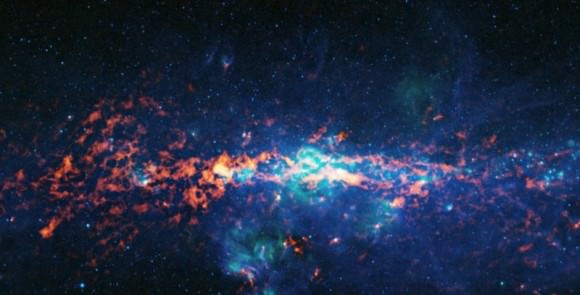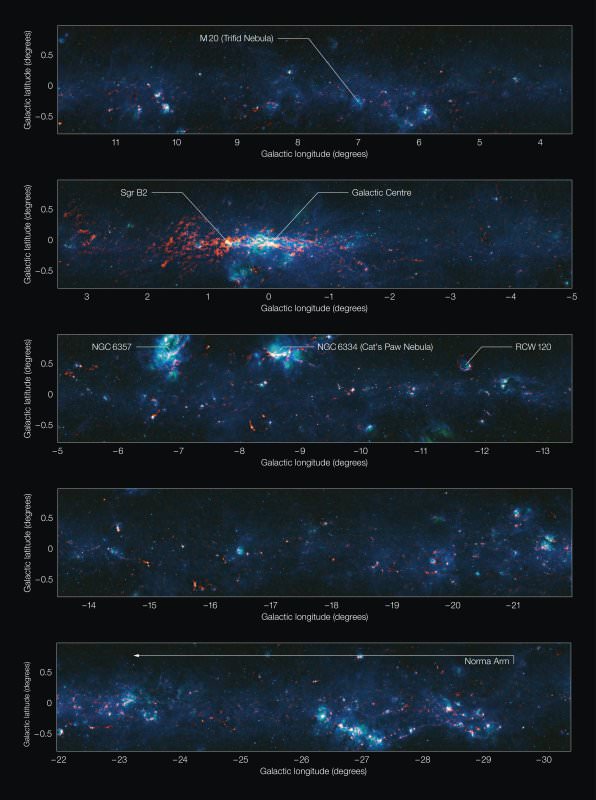[/caption]
All you galactic hitchhikers take note: a new atlas of the inner regions of the Milky Way was released today, showing thousands of previously undiscovered dense knots of cold cosmic dust — the potential birthplaces of new stars. This new map of the home galaxy was made using observations from the APEX telescope in Chile, showing the Milky Way in submillitere wavelengths. “ATLASGAL gives us a new look at the Milky Way. Not only will it help us investigate how massive stars form, but it will also give us an overview of the larger-scale structure of our galaxy”, said Frederic Schuller from the Max Planck Institute for Radio Astronomy, leader of the ATLASGAL team.
So, grab your towels and let’s head out!
This is the largest map available of cold dust, and astronomers say it will provide an invaluable map for observations made with the forthcoming ALMA telescope, as well as the recently launched ESA Herschel space telescope.
The area of the new submillimeter map is approximately 95 square degrees, covering a very long and narrow strip along the galactic plane two degrees wide (four times the width of the full Moon) and over 40 degrees long. The 16,000 pixel-long map was made with the LABOCA submillimeter-wave camera on the ESO-operated APEX telescope. APEX is located at an altitude of 5100 m on the arid plateau of Chajnantor in the Chilean Andes — a site that allows optimal viewing in the submillimeter range. The Universe is relatively unexplored at submillimeter wavelengths, as extremely dry atmospheric conditions and advanced detector technology are required for such observations.
And click here to see an annotated pan of part of the galactic plane.
Highlights of the map include the center of the Milky Way, the nearby massive and dense cloud of molecular gas called Sagittarius B2, and a bubble of expanding gas called RCW120, where the interstellar medium around the bubble is collapsing and forming new stars.

“It’s exciting to get our first look at ATLASGAL, and we will be increasing the size of the map over the next year to cover all of the galactic plane visible from the APEX site on Chajnantor, as well as combining it with infrared observations to be made by the ESA Herschel Space Observatory. We look forward to new discoveries made with these maps, which will also serve as a guide for future observations with ALMA”, said Leonardo Testi from ESO, who is a member of the ATLASGAL team and the European Project Scientist for the ALMA project.
The interstellar medium — the material between the stars — is composed of gas and grains of cosmic dust, rather like fine sand or soot. However, the gas is mostly hydrogen and relatively difficult to detect, so astronomers often search for these dense regions by looking for the faint heat glow of the cosmic dust grains.
Submillimetre light allows astronomers to see these dust clouds shining, even though they obscure our view of the Universe at visible light wavelengths.
The newly released map also reveals thousands of dense dust clumps, many never seen before, which mark the future birthplaces of massive stars. The clumps are typically a couple of light-years in size, and have masses of between ten and a few thousand times the mass of our Sun. In addition, ATLASGAL has captured images of beautiful filamentary structures and bubbles in the interstellar medium, blown by supernovae and the winds of bright stars.
Source: ESO


“Oooh, shiny!”
Nancy, thanks for taking care with a road story that matches the quality and experience of the photos!